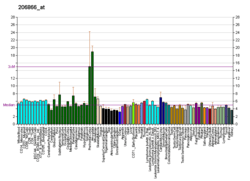CDH4
Cadherin-4 is a protein that in humans is encoded by the CDH4 gene.[5][6][7]
This gene is a classical cadherin from the cadherin superfamily. The encoded protein is a calcium-dependent cell-cell adhesion glycoprotein composed of five extracellular cadherin repeats, a transmembrane region and a highly conserved cytoplasmic tail. Based on studies in chicken and mouse, this cadherin is thought to play an important role during brain segmentation and neuronal outgrowth. In addition, a role in kidney and muscle development is indicated. Of particular interest are studies showing stable cis-heterodimers of cadherins 2 and 4 in cotransfected cell lines. Previously thought to interact in an exclusively homophilic manner, this is the first evidence of cadherin heterodimerization.[7]
Interactions
Cadherin-4 has been shown to interact with:
References
- 1 2 3 ENSG00000179242 GRCh38: Ensembl release 89: ENSG00000280641, ENSG00000179242 - Ensembl, May 2017
- 1 2 3 GRCm38: Ensembl release 89: ENSMUSG00000000305 - Ensembl, May 2017
- ↑ "Human PubMed Reference:".
- ↑ "Mouse PubMed Reference:".
- ↑ Chalmers IJ, Hofler H, Atkinson MJ (Jun 1999). "Mapping of a cadherin gene cluster to a region of chromosome 5 subject to frequent allelic loss in carcinoma". Genomics. 57 (1): 160–3. doi:10.1006/geno.1998.5717. PMID 10191097.
- ↑ Kools P, Vanhalst K, van Roy F (Oct 1999). "Assignment of cadherin-4 (R-cadherin, CDH4) to human chromosome band 20q13.3". Cytogenet Cell Genet. 86 (1): 26–7. doi:10.1159/000015423. PMID 10516427.
- 1 2 "Entrez Gene: CDH4 cadherin 4, type 1, R-cadherin (retinal)".
- ↑ Brady-Kalnay SM, Mourton T, Nixon JP, Pietz GE, Kinch M, Chen H, et al. (1998). "Dynamic interaction of PTPmu with multiple cadherins in vivo". J Cell Biol. 141 (1): 287–96. doi:10.1083/jcb.141.1.287. PMC 2132733. PMID 9531566.
Further reading
- Tagliarini F (1977). "[Relations between social defense and criminological trends from the 1930s until today]". Quaderni di criminologia clinica. 18 (3): 289–352. PMID 798233.
- Suzuki S, Sano K, Tanihara H (1991). "Diversity of the cadherin family: evidence for eight new cadherins in nervous tissue". Cell Regul. 2 (4): 261–70. doi:10.1091/mbc.2.4.261. PMC 361775. PMID 2059658.
- Tanihara H, Sano K, Heimark RL, et al. (1995). "Cloning of five human cadherins clarifies characteristic features of cadherin extracellular domain and provides further evidence for two structurally different types of cadherin". Cell Adhes. Commun. 2 (1): 15–26. doi:10.3109/15419069409014199. PMID 7982033.
- Shan WS, Tanaka H, Phillips GR, et al. (2000). "Functional cis-heterodimers of N- and R-cadherins". J. Cell Biol. 148 (3): 579–90. doi:10.1083/jcb.148.3.579. PMC 2174798. PMID 10662782.
- Lecanda F, Cheng SL, Shin CS, et al. (2000). "Differential regulation of cadherins by dexamethasone in human osteoblastic cells". J. Cell. Biochem. 77 (3): 499–506. doi:10.1002/(SICI)1097-4644(20000601)77:3<499::AID-JCB14>3.0.CO;2-0. PMID 10760957.
- Kitagawa M, Natori M, Murase S, et al. (2000). "Mutation analysis of cadherin-4 reveals amino acid residues of EC1 important for the structure and function". Biochem. Biophys. Res. Commun. 271 (2): 358–63. doi:10.1006/bbrc.2000.2636. PMID 10799302.
- Deloukas P, Matthews LH, Ashurst J, et al. (2002). "The DNA sequence and comparative analysis of human chromosome 20". Nature. 414 (6866): 865–71. doi:10.1038/414865a. PMID 11780052.
- Strausberg RL, Feingold EA, Grouse LH, et al. (2003). "Generation and initial analysis of more than 15,000 full-length human and mouse cDNA sequences". Proc. Natl. Acad. Sci. U.S.A. 99 (26): 16899–903. doi:10.1073/pnas.242603899. PMC 139241. PMID 12477932.
- Ota T, Suzuki Y, Nishikawa T, et al. (2004). "Complete sequencing and characterization of 21,243 full-length human cDNAs". Nat. Genet. 36 (1): 40–5. doi:10.1038/ng1285. PMID 14702039.
- Johnson E, Theisen CS, Johnson KR, Wheelock MJ (2004). "R-cadherin influences cell motility via Rho family GTPases". J. Biol. Chem. 279 (30): 31041–9. doi:10.1074/jbc.M400024200. PMID 15143071.
- Gerhard DS, Wagner L, Feingold EA, et al. (2004). "The status, quality, and expansion of the NIH full-length cDNA project: the Mammalian Gene Collection (MGC)". Genome Res. 14 (10B): 2121–7. doi:10.1101/gr.2596504. PMC 528928. PMID 15489334.
- Miotto E, Sabbioni S, Veronese A, et al. (2005). "Frequent aberrant methylation of the CDH4 gene promoter in human colorectal and gastric cancer". Cancer Res. 64 (22): 8156–9. doi:10.1158/0008-5472.CAN-04-3000. PMID 15548679.
- Maeda M, Johnson E, Mandal SH, et al. (2006). "Expression of inappropriate cadherins by epithelial tumor cells promotes endocytosis and degradation of E-cadherin via competition for p120(ctn)". Oncogene. 25 (33): 4595–604. doi:10.1038/sj.onc.1209396. PMID 16786001.
External links
- CDH4 human gene location in the UCSC Genome Browser.
- CDH4 human gene details in the UCSC Genome Browser.




